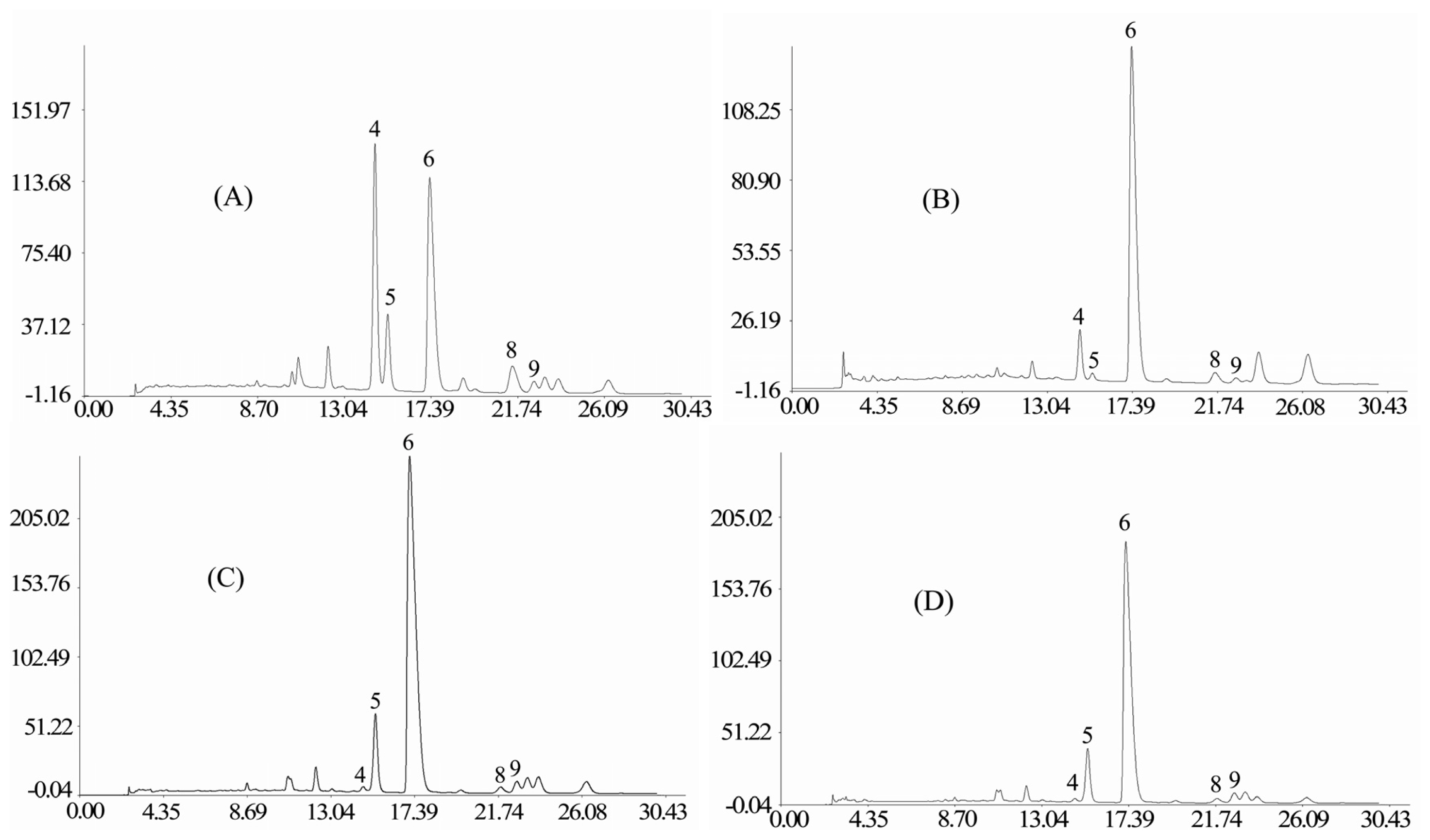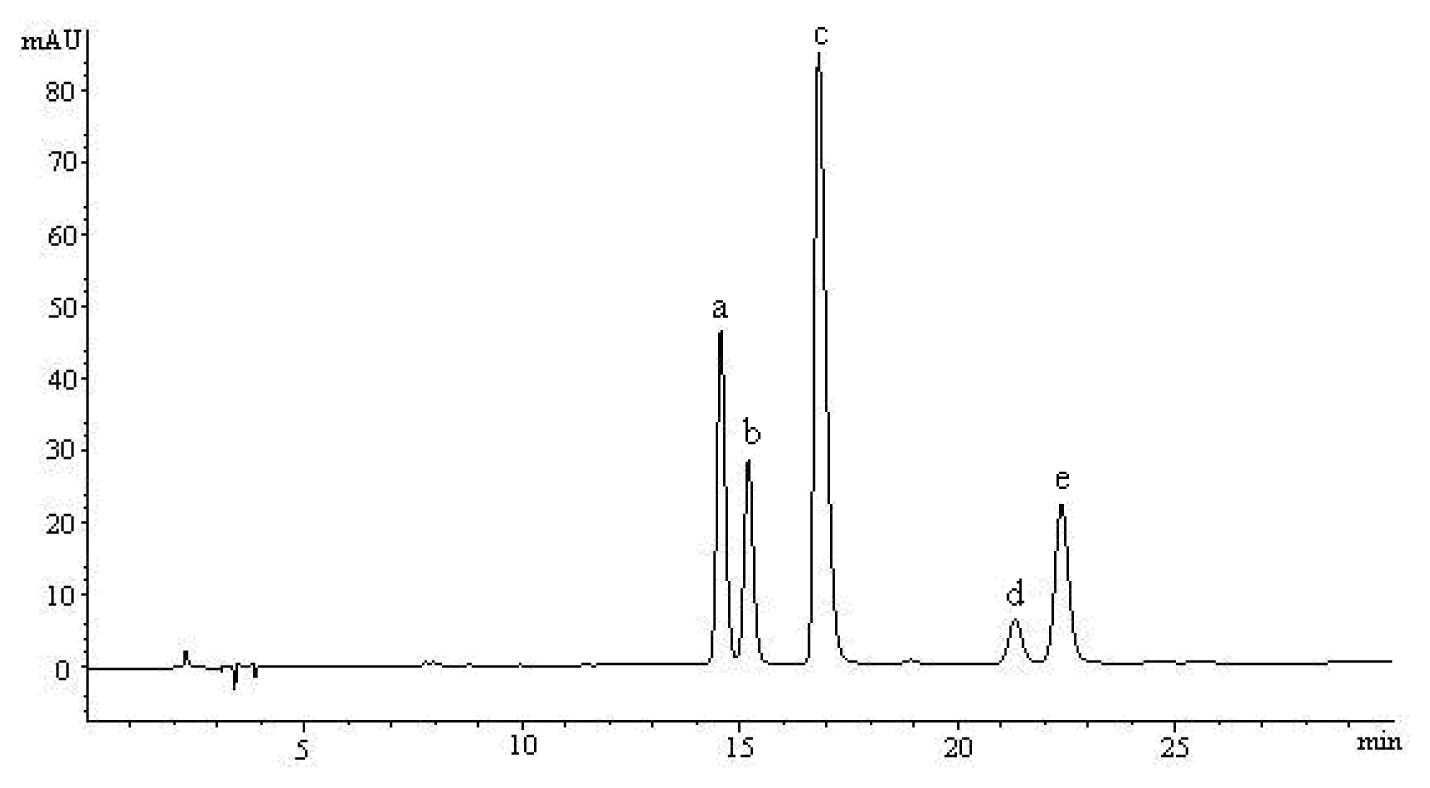Quantitative and Chemical Fingerprint Analysis for the Quality Evaluation of Receptaculum Nelumbinis by RP-HPLC Coupled with Hierarchical Clustering Analysis
Abstract
:1. Introduction
2. Results and Discussion
2.1. Optimization of HPLC Conditions
2.2. Method Validation of Quantitative Analysis
2.3. Establishment of Chromatographic Fingerprint of Receptaculum Nelumbinis and Similarity Analysis (SA)
2.4. Quantitative Determination of Five Compounds in Receptaculum Nelumbinis
2.5. Hierarchical Clustering Analysis (HCA)
3. Experimental Section
3.1. Plant Materials and Reagents
3.2. Instrument and Chromatographic Conditions
3.3. Preparation of Standard Solutions
3.4. Preparation of Sample Solutions
3.5. Data Analysis
4. Conclusions
Acknowledgments
- Conflict of InterestThe authors declare no conflict of interest.
References
- Woranuch, L.; Chusie, T.; Henrik, B. Management and use of Nelumbo nucifera Gaertn. In Thai wetlands. Wetl. Ecol. Manag 2009, 17, 279–289. [Google Scholar]
- Guo, H.B. Cultivation of lotus (Nelumbo nucifera Gaertn. ssp. nucifera) and its utilization in China. Genet. Resour. Crop Evol 2009, 56, 323–330. [Google Scholar]
- Han, Y.C.; Teng, C.Z.; Chang, F.H.; Robert, G.W.; Zhou, M.Q.; Hu, Z.L.; Song, Y.H. Analyses of genetic relationships in Nelumbo nucifera using nuclear ribosomal ITS sequence data, ISSR and RAPD markers. Aquat. Botan 2007, 87, 141–146. [Google Scholar]
- Liu, J.; Chen, X.; Yang, W.; Zhang, S.; Wang, F.; Tang, Z. Chemical fingerprinting of wild germplasm resource of Ophiopogon japonicus from Sichuan basin, China by RP-HPLC coupled with hierarchical cluster analysis. Anal. Lett 2010, 43, 2411–2423. [Google Scholar]
- Ishida, H.; Umino, T.; Tsuji, K.; Kosuge, T. Studies on the antihemorrhagic substances in herbs classified as hemostatics in Chinese medicine. VIII. On the antihemorrhagic principle in Nelumbins Receptaculum. Chem. Pharm. Bull 1988, 36, 4585–4587. [Google Scholar]
- Wu, Y.B.; Zheng, L.J.; Yi, J.; Wu, J.G.; Tan, C.J.; Chen, T.Q.; Wu, J.Z.; Wong, K.H. A comparative study on antioxidant activity of ten different parts of Nelumbo nucifera Gaertn. Afr. J. Pharm. Pharmacol 2011, 5, 2454–2461. [Google Scholar]
- Gong, Y.S.; Liu, L.G.; Xie, B.J.; Liao, Y.C.; Yang, E.L.; Sun, Z.D. Ameliorative effects of lotus seedpod proanthocyanidins on cognitive deficits and oxidative damage in senescence-accelerated mice. Behav. Brain Res 2008, 194, 100–107. [Google Scholar]
- Zhang, X.H.; Zhang, B.; Gong, P.L.; Zeng, F.D. Protective effect of procyanidins from the seedpod of the lotus on myocardial ischemia and its mechanisms. Yao Xue Xue Bao 2004, 39, 747–750. [Google Scholar]
- Duan, Y.; Zhang, H.; Xie, B.; Yan, Y.; Li, J.; Xu, F.; Qin, Y. Whole body radioprotective activity of an acetone-water extract from the seedpod of Nelumbo nucifera Gaertn. Food Chem. Toxicol 2010, 48, 3374–3384. [Google Scholar]
- Duan, Y.; Zhang, H.; Xu, F.; Xie, B.; Yang, X.; Wang, Y.; Yan, Y. Inhibition effect of procyanidins from lotus seedpod on mouse B16 melanoma in vivo and in vitro. Food Chem 2010, 122, 84–91. [Google Scholar]
- Wu, Y.B.; Zheng, L.J.; Wu, J.G.; Chen, T.Q.; Yi, J.; Wu, J.Z. Antioxidant activities of extract and fractions from Receptaculum Nelumbinis and related flavonol glycosides. Int. J. Mol. Sci 2012, 13, 7163–7173. [Google Scholar]
- Chinese Pharmacopoeia Committee, Pharmacopoeia of the People’s Republic of China; Chemical Industry Press: Beijing, China, 2010; Volume 1, pp. 193–195.
- Wang, J.; Liu, Y.; Cheng, B.; Shi, Y.; Chen, H. The research on the isolation and identification of hyperin in Receptaculum Nelumbinis and quality standard of Receptaculum Nelumbinis. J. Chengdu Med. Coll 2008, 3, 35–37. [Google Scholar]
- Wang, C.; Zhang, X. Determination of hyperin and quercetin in different processed products of Nelumbins Receptaculum by HPLC. Chin. Tradit. Patent Med 2010, 32, 1729–1732. [Google Scholar]
- Fan, L.L.; Tu, P.F.; Chen, H.B.; Cai, S.Q. Simultaneous quantification of five major constituents in stems of Dracaena plants and related medicinal preparations from China and Vietnam by HPLC-DAD. Biomed. Chromatogr 2009, 23, 1191–1200. [Google Scholar]
- Li, Z.; Liu, J.; Hu, J.; Li, X.; Wang, S.; Yi, D.; Zhao, M. Protective effects of hyperoside against human umbilical vein endothelial cell damage induced by hydrogen peroxide. J. Ethnopharmacol 2012, 139, 388–394. [Google Scholar]
- Silva, C.G.; Raulinoa, R.J.; Cerqueirab, D.M.; Mannarinoa, S.C.; Pereira, M.D.; Paneka, A.D.; Silvac, J.F.M.; Menezes, F.S.; Eleutherio, E.C.A. In vitro and in vivo determination of antioxidant activity and mode of action of isoquercitrin and Hyptis fasciculata. Phytomedicine 2009, 16, 761–767. [Google Scholar]
- Yoshizumi, M.; Tsuchiya, K.; Suzaki, Y.; Kirima, K.; Kyaw, M.; Moon, J.; Terao, J.; Tamaki, T. Quercetin glucuronide prevents VSMC hypertrophy by angiotensin II via the inhibition of JNK and AP-1signaling pathway. Biochem. Bioph. Res. Commun 2002, 293, 1458–1465. [Google Scholar]
- Fan, D.; Zhou, X.; Zhao, C.; Chen, H.; Zhao, Y.; Gong, X. Anti-Inflammatory, antiviral and quantitative study of quercetin-3-O-β-d-glucuronide in Polygonum perfoliatum L. Fitoterapia 2011, 82, 805–810. [Google Scholar]
- Yang, J.H.; Hsia, T.C.; Kuo, H.M.; Chao, P.D.L.; Chou, C.C.; Wei, Y.H.; Chung, J.G. Inhibition of lung cancer cell growth by quercetin glucuronides via G2/M arrest and induction of apoptosis. Drug Metab. Dispos 2006, 34, 296–304. [Google Scholar]
- Kong, W.; Zhao, Y.; Xiao, X.; Jin, C.; Li, Z. Quantitative and chemical fingerprint analysis for quality control of Rhizoma Coptidischinensis based on UPLC-PAD combined with chemometrics methods. Phytomedicine 2009, 16, 950–959. [Google Scholar]
- Zou, P.; Hong, Y.; Koh, H.L. Chemical fingerprinting of Isatis indigotica root by RP-HPLC and hierarchical clustering analysis. J. Pharmaceut. Biomed. Anal 2005, 38, 514–520. [Google Scholar]
- Lu, F.; Li, D.; Fu, C.; Liu, J.; Huang, Y.; Chen, Y.; Wen, Y.; Nohara, T. Studies on chemical fingerprints of Siraitia grosvenorii fruits (Luo Han Guo) by HPLC. J. Nat. Med 2012, 66, 70–76. [Google Scholar]
- Liang, Y.Z.; Xie, P.; Chan, K. Quality control of herbal medicines. J. Chromatogr. B 2004, 812, 53–70. [Google Scholar]




| Compound | Regression equationa | Rb | Linearity range (μg/mL) |
|---|---|---|---|
| Hyperoside | Y = 25.303x + 13.352 | 0.9998 | 8–104 μg/mL |
| Isoquercitrin | Y = 16.058x + 22.746 | 0.9991 | 2–64 μg/mL |
| Quercetin-3-O-β-d-glucuronide | Y = 9.6542x − 26.718 | 0.9998 | 30–960 μg/mL |
| Isorhamnetin-3-O-β-d-galactoside | Y = 19.097x − 1.1527 | 0.9999 | 1.4–42.6 μg/mL |
| Syringetin-3-O-β-d-glucoside | Y = 13.305x + 0.9321 | 0.9997 | 0.7–22.8 μg/mL |
| Compound | Precision RSD (%) (n = 6) | Reproducibility RSD (%) (n = 6) | Stability RSD (%) (n = 6) | Recovery (%) (n = 6) Mean ± RSD (%) |
|---|---|---|---|---|
| Hyperoside | 0.07 | 1.99 | 0.09 | 99.23 ± 2.61 |
| Isoquercitrin | 0.14 | 2.37 | 0.17 | 99.72 ± 2.84 |
| Quercetin-3-O-β-d-glucuronide | 0.48 | 2.88 | 0.68 | 99.54 ± 2.91 |
| Isorhamnetin-3-O-β-d-galactoside | 0.08 | 2.44 | 0.18 | 98.31 ± 3.00 |
| Syringetin-3-O-β-d-glucoside | 0.49 | 2.96 | 0.69 | 100.32 ± 2.71 |
| Samples | Similarities |
|---|---|
| L1 | 0.956 |
| L2 | 0.962 |
| L3 | 0.934 |
| L4 | 0.957 |
| L5 | 0.954 |
| L6 | 0.941 |
| L7 | 0.918 |
| L8 | 0.959 |
| L9 | 0.966 |
| L10 | 0.959 |
| L11 | 0.867 |
| L12 | 0.961 |
| L13 | 0.283 |
| L14 | 0.959 |
| L15 | 0.965 |
| L16 | 0.966 |
| L17 | 0.282 |
| L18 | 0.965 |
| L19 | 0.956 |
| L20 | 0.956 |
| Samples | Cultivated varieties | Collected location | Collection time | Contents (mg/g) | ||||
|---|---|---|---|---|---|---|---|---|
| 1a | 2 | 3 | 4 | 5 | ||||
| L1 | Taikong 36 | Jianou, Fujian | October 2010 | 7.4 | 3.9 | 27.0 | 2.1 | 1.0 |
| L2 | Zajiao 8236 | Jianou, Fujian | October 2010 | 6.2 | 2.9 | 29.1 | 1.8 | 0.9 |
| L3 | Jianjibaihualian | Jianou, Fujian | October 2010 | 5.5 | 4.9 | 18.4 | 1.3 | 0.6 |
| L4 | Guangchang Taikong 3 | Guangchang, Jiangxi | September 2010 | 2.5 | 1.4 | 14.7 | 1.2 | 0.7 |
| L5 | Baihualian | Guangchang, Jiangxi | September 2010 | 1.4 | 0.5 | 8.5 | 0.6 | 0.3 |
| L6 | Shilihe 1 | Hangzhou, Zhejiang | September 2010 | 2.9 | 1.8 | 9.3 | 0.3 | 0.4 |
| L7 | Liyebailian | Hangzhou, Zhejiang | September 2010 | 0.8 | 0.2 | 9.4 | 0.3 | 0.1 |
| L8 | Jianxuan 17 | Hangzhou, Zhejiang | August 2010 | 6.8 | 6.0 | 41.8 | 1.4 | 1.5 |
| L9 | Taikong 3 | Hangzhou, Zhejiang | August 2010 | 7.9 | 3.8 | 33.7 | 1.9 | 1.1 |
| L10 | Ganxuan 62 | Hangzhou, Zhejiang | August 2010 | 2.6 | 1.7 | 14.4 | 0.4 | 0.4 |
| L11 | Jinfunong | Hangzhou, Zhejiang | August 2010 | 1.1 | 0.1 | 30.6 | 0.6 | 0.4 |
| L12 | Dahonglian | Hangzhou, Zhejiang | August 2010 | 7.3 | 3.6 | 29.7 | 0.9 | 1.0 |
| L13 | Guanshanglian | Yuanmingyuan, Beijing | August 2010 | 0.2 | 5.5 | 76.2 | 0.6 | 1.4 |
| L14 | Baoyingmeirenhonglian | Baoying, Jiangsu | August 2010 | 4.4 | 3.2 | 19.3 | 0.8 | 0.5 |
| L15 | Honghelian | Honghu, Hubei | August 2010 | 4.1 | 2.1 | 21.3 | 1.2 | 0.8 |
| L16 | Jianlian | Jianning, Fujian | August 2010 | 4.1 | 2.1 | 21.3 | 1.2 | 0.8 |
| L17 | Baiyangdingyeshenglian | Baoding, Hebei | August 2010 | 0.1 | 3.6 | 49.2 | 0.4 | 1.1 |
| L18 | Xingkongmudan | Guangchang, Jiangxi | August 2010 | 7.5 | 4.2 | 34.8 | 1.5 | 0.9 |
| L19 | Cunsanlian | Xiangtan, Hunan | August 2010 | 4.8 | 2.8 | 19.8 | 0.6 | 0.7 |
| L20 | Taikong 1 | Hangzhou, Zhejiang | August 2010 | 9.1 | 3.2 | 36.5 | 3.3 | 1.9 |
© 2013 by the authors; licensee Molecular Diversity Preservation International, Basel, Switzerland. This article is an open-access article distributed under the terms and conditions of the Creative Commons Attribution license (http://creativecommons.org/licenses/by/3.0/).
Share and Cite
Wu, Y.-B.; Zheng, L.-J.; Yi, J.; Wu, J.-G.; Chen, T.-Q.; Wu, J.-Z. Quantitative and Chemical Fingerprint Analysis for the Quality Evaluation of Receptaculum Nelumbinis by RP-HPLC Coupled with Hierarchical Clustering Analysis. Int. J. Mol. Sci. 2013, 14, 1999-2010. https://doi.org/10.3390/ijms14011999
Wu Y-B, Zheng L-J, Yi J, Wu J-G, Chen T-Q, Wu J-Z. Quantitative and Chemical Fingerprint Analysis for the Quality Evaluation of Receptaculum Nelumbinis by RP-HPLC Coupled with Hierarchical Clustering Analysis. International Journal of Molecular Sciences. 2013; 14(1):1999-2010. https://doi.org/10.3390/ijms14011999
Chicago/Turabian StyleWu, Yan-Bin, Li-Jun Zheng, Jun Yi, Jian-Guo Wu, Ti-Qiang Chen, and Jin-Zhong Wu. 2013. "Quantitative and Chemical Fingerprint Analysis for the Quality Evaluation of Receptaculum Nelumbinis by RP-HPLC Coupled with Hierarchical Clustering Analysis" International Journal of Molecular Sciences 14, no. 1: 1999-2010. https://doi.org/10.3390/ijms14011999




